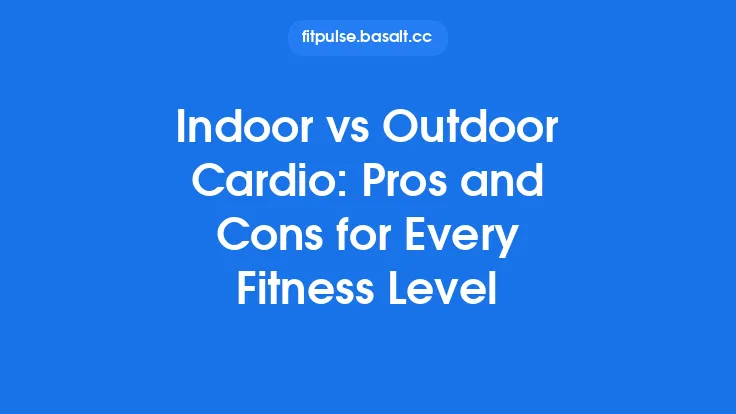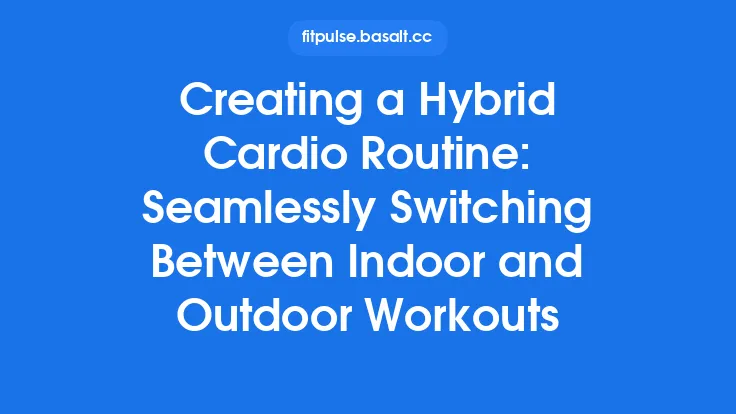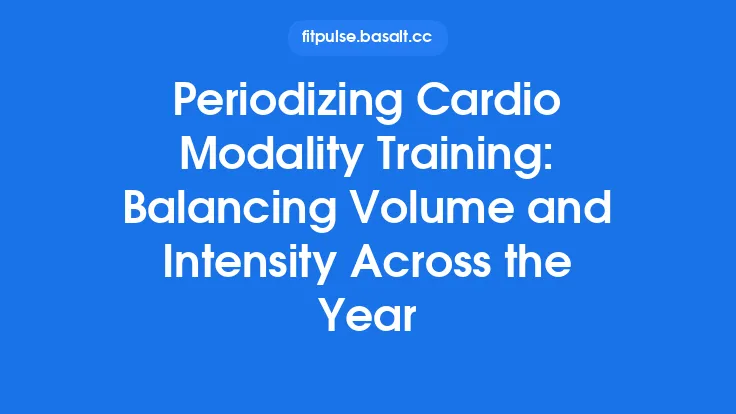Balancing indoor and outdoor cardio when temperatures swing to the extremes can feel like walking a tightrope. One day the sun blazes, turning sidewalks into ovens; the next, a biting wind makes every breath feel like a gasp of ice. The key to maintaining consistent cardiovascular conditioning lies in understanding how temperature influences your body, leveraging the strengths of both indoor and outdoor environments, and crafting a flexible routine that lets you train safely and effectively no matter what the thermostat reads.
Understanding the Physiological Stress of Temperature Extremes
Heat Load – When ambient temperatures rise, your body must dissipate excess heat to keep core temperature within a narrow, safe range (≈ 36.5–37.5 °C). Cardiovascular strain increases because blood is redirected toward the skin for cooling, which can reduce the amount of blood available to the working muscles. This manifests as a higher heart‑rate response at a given workload and an earlier onset of perceived fatigue.
Cold Load – In frigid conditions, the opposite occurs: blood vessels constrict to preserve core heat, limiting peripheral circulation. Muscles become less pliable, and the body expends additional energy to generate heat (shivering thermogenesis). The net effect is a higher oxygen cost for the same mechanical output, often reflected in an elevated heart‑rate zone.
Both extremes also affect the autonomic nervous system, shifting the balance between sympathetic (fight‑or‑flight) and parasympathetic (recovery) tones. Recognizing these shifts helps you adjust intensity, duration, and recovery strategies appropriately.
Assessing Your Environment – Tools and Metrics
Before deciding whether to lace up for a run outside or hop onto a treadmill, gather objective data:
| Metric | Why It Matters | Typical Tools |
|---|---|---|
| Ambient temperature | Directly influences heat‑ or cold‑stress | Thermometer, smartphone weather app |
| Relative humidity (for heat) | Affects evaporative cooling efficiency | Hygrometer, weather app |
| Wind speed (for cold) | Increases convective heat loss | Anemometer, weather app |
| Heat Index / Wind Chill | Composite values that better predict perceived stress | Online calculators, weather services |
| Air quality (PM2.5, ozone) | Poor air can exacerbate respiratory strain, especially in extreme temps | AQI apps, local monitoring stations |
| Indoor climate control settings | Determines how closely indoor conditions can mimic a comfortable “neutral” zone (≈ 20–22 °C) | Thermostat, smart home sensors |
By logging these variables, you can set quantitative thresholds (e.g., “if heat index > 35 °C, move indoors”) rather than relying on guesswork.
Choosing the Right Indoor Modality for Hot or Cold Days
When the outdoors is hostile, the indoor environment becomes your training sanctuary. Selecting the appropriate cardio modality can help you maintain the desired stimulus while minimizing thermal strain.
- Treadmill Running – Allows precise speed and incline control. Use a fan or air‑conditioning to keep ambient temperature in the 18–22 °C range. Adjust the incline to simulate outdoor terrain without increasing speed, thereby reducing metabolic heat production.
- Stationary Cycling – Generates less impact stress and can be performed at lower body temperatures. The seated position promotes better airflow across the skin, especially when paired with a desk fan.
- Elliptical or Cross‑Trainer – Engages both upper and lower body, distributing metabolic heat across a larger surface area, which can aid in heat dissipation.
- Rowing Machine – Provides a full‑body workout with relatively low external heat generation. The rhythmic motion encourages deep breathing, which can help regulate core temperature.
- High‑Intensity Interval Training (HIIT) on a Rower or Bike – Short bursts of effort followed by longer recovery periods limit overall heat buildup, making it suitable for hot indoor sessions.
When the indoor climate is cold, consider adding a light heating element (e.g., a space heater set to a safe temperature) or layering with breathable, moisture‑wicking garments to prevent muscle stiffness without overheating.
Optimizing Outdoor Sessions When Conditions Are Manageable
Even in extreme seasons, there are windows of opportunity for safe outdoor cardio. Maximizing those windows involves strategic timing and environmental awareness.
- Early Morning or Late Evening – Temperatures are typically at their lowest during summer and highest during winter. Align your workouts with these natural temperature troughs.
- Micro‑climate Selection – Urban canyons, shaded parks, or wind‑protected valleys can moderate temperature extremes. Use local knowledge or satellite imagery to identify such zones.
- Surface Choice – Softer surfaces (grass, packed dirt) reduce impact forces, which can be beneficial when muscles are stiff from cold. Conversely, paved surfaces may retain heat longer in summer, offering a slightly warmer footing.
- Dynamic Pacing – Start at a lower intensity to allow your body to acclimate to the ambient temperature, then gradually increase effort as you gauge thermal comfort.
- Real‑Time Monitoring – Wear a heart‑rate monitor or a smart watch with skin‑temperature sensors. If heart‑rate drifts upward disproportionately to effort, it may signal excessive thermal stress, prompting a cooldown or transition indoors.
Hybrid Scheduling – How to Blend Indoor and Outdoor Workouts
A balanced cardio program leverages the strengths of both environments while mitigating their weaknesses. Here’s a practical framework:
- Baseline Assessment – Determine your weekly cardio volume goal (e.g., 150 min of moderate‑intensity or 75 min of vigorous‑intensity per guidelines).
- Environmental Mapping – Plot typical temperature trends for your region across the year. Identify “comfort windows” (e.g., 10 °C–20 °C) and “stress windows” (outside that range).
- Allocation Matrix
| Weekday | Preferred Setting | Rationale |
|---|---|---|
| Monday | Indoor (treadmill) | Start the week with controlled conditions to gauge baseline fatigue. |
| Tuesday | Outdoor (run) | If temperature falls within comfort window, capitalize on fresh air. |
| Wednesday | Indoor (HIIT bike) | Mid‑week intensity boost without external thermal load. |
| Thursday | Outdoor (cycle) | Longer, steady‑state session when wind is low. |
| Friday | Indoor (rower) | Low‑impact, full‑body work to offset cumulative joint stress. |
| Saturday | Outdoor (choice) | Flexible “free day” – pick based on real‑time weather. |
| Sunday | Rest or active recovery (light indoor elliptical) | Gentle movement to promote circulation. |
- Flex‑Day Protocol – On days when the forecast flips unexpectedly, have a pre‑planned indoor alternative ready (e.g., a 30‑minute treadmill interval if a heatwave hits).
By pre‑structuring your week, you reduce decision fatigue and ensure that temperature extremes never derail your cardio consistency.
Monitoring Intensity and Recovery Across Settings
Thermal stress can mask true training load, making objective monitoring essential.
- Heart‑Rate Zones – Use a percentage of your maximum heart rate (HRmax) rather than perceived effort alone. In heat, you may notice a 5–10 % upward shift in heart‑rate for a given speed; adjust zones accordingly.
- Rate of Perceived Exertion (RPE) – Pair RPE with heart‑rate data. A higher RPE at a stable heart‑rate suggests added thermal strain.
- Heart‑Rate Variability (HRV) – Daily HRV readings can reveal autonomic balance. A dip in HRV after several hot or cold sessions may indicate insufficient recovery.
- Recovery Metrics – Track sleep quality, resting heart‑rate, and subjective soreness. Extreme temperatures often increase recovery demands, so allocate extra rest or low‑intensity days as needed.
Practical Tips for Comfort and Safety
- Layer Strategically – In cold weather, wear a thin, moisture‑wicking base layer, an insulating mid‑layer, and a wind‑proof outer shell that can be removed as you warm up. In heat, opt for loose, breathable fabrics that promote sweat evaporation.
- Protect Extremities – Gloves, hats, and socks can prevent peripheral vasoconstriction in cold, while lightweight caps or headbands can shield sweat from dripping into eyes during heat.
- Footwear Fit – While detailed footwear selection is beyond this scope, ensure shoes are snug enough to prevent slippage but not so tight that they restrict circulation, which can exacerbate temperature regulation issues.
- Ventilation – For indoor sessions, position fans to create a cross‑draft across the torso and limbs. In hot climates, a combination of fan and air‑conditioning is more effective than either alone.
- Surface Temperature Check – On very hot days, pavement can exceed 60 °C, risking burns. Test surface temperature with the back of your hand; if it feels uncomfortably hot, choose a shaded trail or move indoors.
Adapting Equipment and Space for Temperature Control
- Portable Climate Units – Small, energy‑efficient air‑conditioners or evaporative coolers can be positioned near a treadmill or bike to maintain a comfortable micro‑environment without cooling the entire room.
- Insulated Flooring – In cold months, place rubber mats or interlocking foam tiles under cardio equipment to reduce heat loss through the floor.
- Reflective Barriers – Use reflective window films or curtains to block solar gain during summer, keeping indoor training spaces cooler.
- Smart Thermostats – Program temperature set‑points that align with your workout schedule, ensuring the space is pre‑conditioned before you begin.
Mental Strategies for Consistency in Extreme Weather
- Goal Framing – Shift focus from “I must run outside” to “I will complete X minutes of cardio at a target intensity,” regardless of location. This mental flexibility reduces the temptation to skip sessions when weather is uncooperative.
- Visualization – Before a cold outdoor run, picture yourself moving smoothly, feeling warm, and maintaining steady breathing. Visualization can prime the nervous system for efficient thermoregulation.
- Micro‑Rewards – Pair indoor sessions with small incentives (e.g., a favorite podcast episode, a post‑workout stretch routine) to reinforce positive associations with training in less‑preferred environments.
- Community Accountability – Join virtual cardio groups where members share daily logs. Knowing others are tracking their indoor or outdoor workouts can motivate you to stay on track despite temperature challenges.
Key Takeaways
- Extreme temperatures impose distinct physiological stresses that alter heart‑rate response, oxygen consumption, and recovery needs.
- Objective environmental data (temperature, humidity, wind chill, air quality) should guide the decision to train indoors or outdoors.
- Indoor cardio modalities—treadmill, bike, elliptical, rower—offer controllable climates and can be fine‑tuned with fans, heaters, or ventilation.
- When outdoor conditions are within a comfortable window, leverage natural terrain, timing, and micro‑climates to preserve variety and enjoyment.
- A hybrid weekly schedule, paired with real‑time monitoring (heart‑rate, HRV, RPE), ensures you meet cardio volume goals without overtaxing the body.
- Practical comfort measures (layering, ventilation, equipment adaptation) and mental strategies (goal framing, community support) sustain consistency throughout the year.
By integrating these principles, you can maintain robust cardiovascular conditioning, stay safe, and keep motivation high—no matter how hot or cold the world outside may be.





